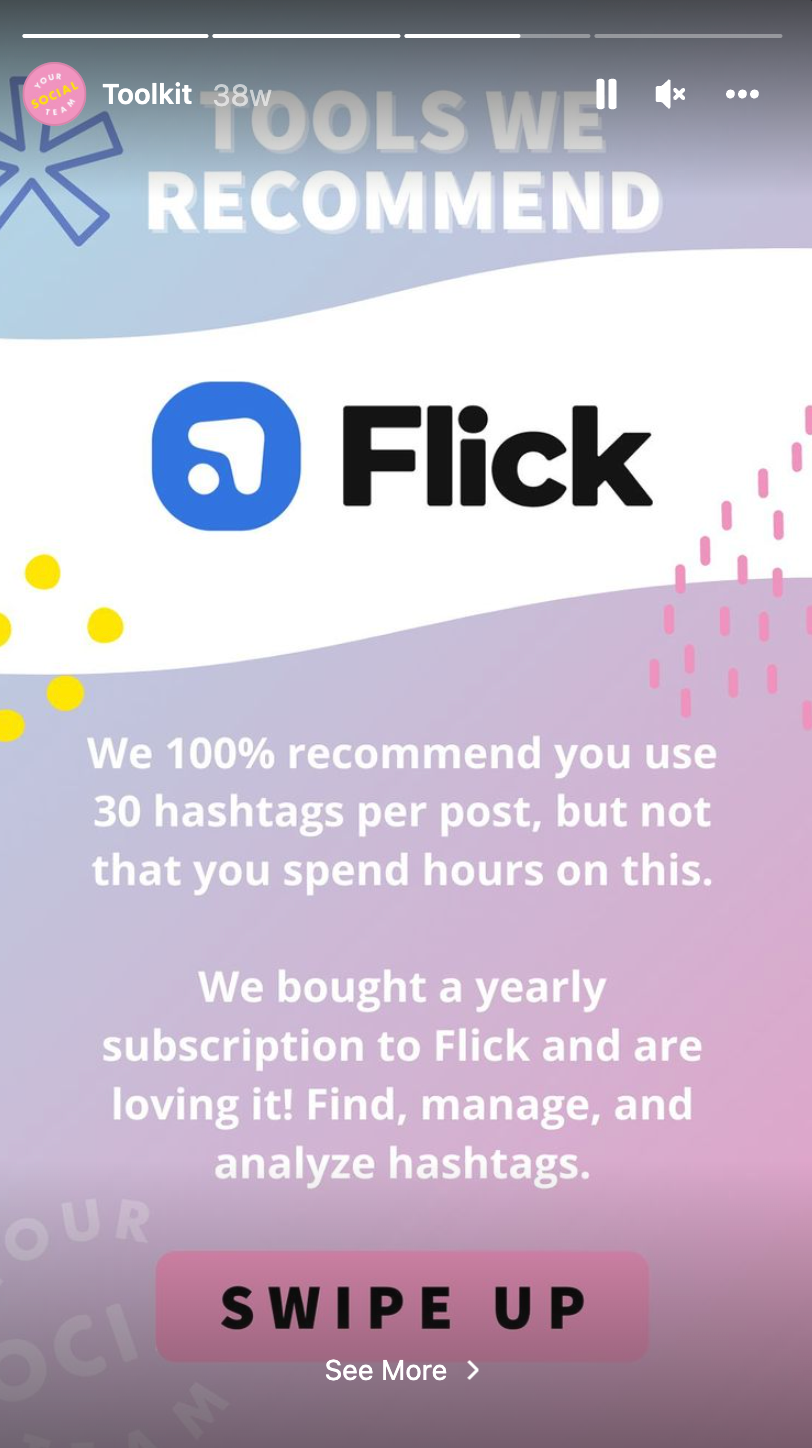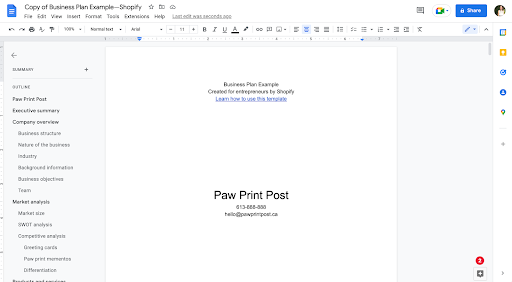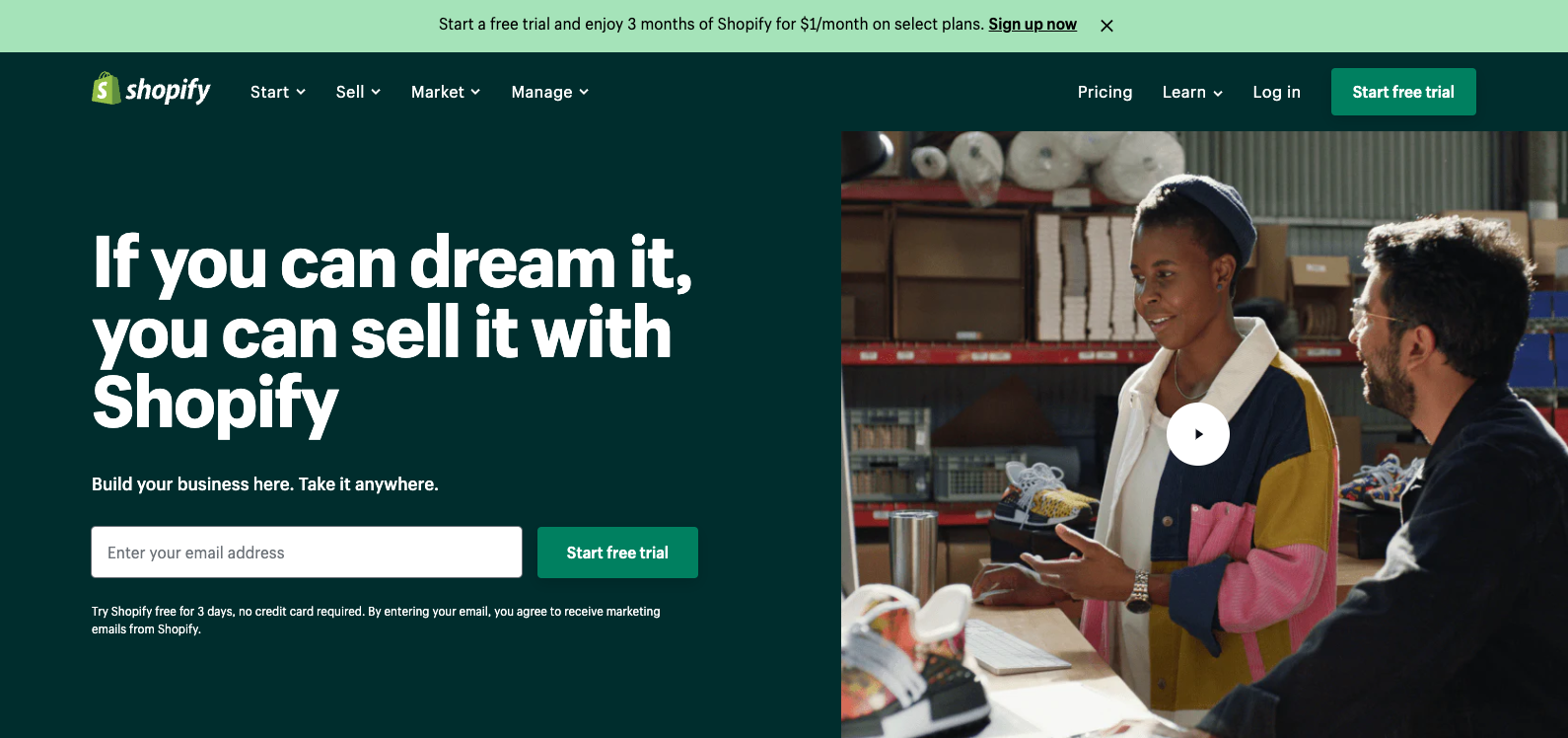Start your business
Build your brand
Create your website
Online store editor
Customize your store
Store themes
Find business apps
Shopify app store
Own your site domain
Domains & hosting
Explore free business tools
Tools to run your business
Sell your products
Sell online or in person
Sell online
Grow your business online
Sell across channels
Reach millions of shoppers and boost sales
Sell in person
Point of Sale (POS)
Sell globally
International sales
Sell wholesale & direct
Business-to-business (B2B)
Market your business
Reach & retain customers
Market across social
Social media integrations
Nurture customers
Shopify Email
Know your audience
Gain customer insights
Manage your business
Track sales, orders & analytics
Measure your performance
Analytics and Reporting
Manage your stock & orders
Inventory & order management
Shopify Developers
Build with Shopify's powerful APIs
Plus
A commerce solution for growing digital brands
All Products
Explore all Shopify products & features
Help and support
Get 24/7 support
How-to guides
Read in-depth business guides
Shopify blog
Business strategy tips
What is Shopify?
How our commerce platform works
Founder stories
Learn from successful merchants
Branding
Build your brand from scratch
Marketing
Build a marketing plan
Ecommerce SEO
Improve your search ranking
Social media strategy
Turn social into sales
Business growth
Scale your business
Business name generator
Logo maker
Stock photography
Business plan template
Link in bio tool
QR code generator
Changelog
Your source for recent updates
Newsroom
All company news and press releases
Start selling with Shopify today
Start your free trial with Shopify today—then use these resources to guide you through every step of the process.
When you think of owning and operating a business, you might think about renting commercial real estate, commuting to an office, or managing employees. But there are plenty of ways you can pursue entrepreneurship with your headquarters at home.
Start your online business today.
For free.
If you’re planning to own and operate a business, you might be thinking about things like renting commercial real estate, commuting to an office, or managing employees. But starting and running a company from home is easier than ever.
Ahead, discover 30 home business ideas to kickstart your entrepreneurship journey along with guidance on how to make it work for you.
A home-based business is a venture—whether full time or run as a side hustle—you can start and operate using your own personal residence as your base of operations. A few home-based businesses, especially those that sell online and don’t buy and hold lots of inventory, can even be run on the go, without the need to be bound to your home.
Naturally, there are pros and cons to consider when deciding whether a home based business is right for you.
While there are plenty of ways to go about starting your home business ideas, the following are some of the most approachable paths to creating a profitable business for yourself.
Many businesses center on the simple concept of importing products in bulk and selling them individually for a profit.
Maybe you recently traveled abroad and came across unique products that aren’t readily available in your market but that you sense an appetite for. Or maybe you’ve zeroed in on a niche market and know the perfect way to serve it.
Either way, if these products are relatively easy to store and ship, you may have some solid home-based small business ideas on your hands.
You can even initially use your home as a showroom to sell locally, giving you the option to expand with additional storage space and employees as you validate your idea and sales start to ramp up. This is how Artemis Design Co. got its start.
“I was living in the south end of Boston, and I had my living room just full of these products,” says Milicent Armstrong, owner and founder of Artemis Design Co. “I would have people come over if they wanted to look at something or try something on, and that’s how I made my first sale.”
If you’re a maker yourself (or know someone who is), consider turning that hobby into a business. Even if you have to create your products elsewhere—in a studio, commercial kitchen, or workshop—you may be able to store and sell them in your own home.
When you control nearly every aspect of the products you sell, you can make them more cost effective, improve their quality, or cater them to a certain audience by targeting demand in the market.
Josh Pigford already had a thriving home business in a business analytics startup, but wanted to find a way to flex his creative muscles. He started printing succulent planters at home with his 3D printer—and a new business was born. Cedar & Sail now carries planters, coasters, and other small desk tchotchkes.
Whether you choose to start on a marketplace like Etsy or build your own branded storefront, selling your creations is a great way to share your passion with others and make money too. Just be wary of regulations concerning products that people ingest or put on their skin.
Check out these resources for launching a home-based business selling handmade products:
Best of all, producing your own products doesn’t have to be overwhelming. When you’re ready to scale, you can establish a process and onboard new employees to help with production.
So far, we’ve covered business ideas that require you to hold inventory in your home. But there are a variety of online businesses ideas to pursue that don’t involve worrying about inventory and shipping.
These businesses employ a dropshipping model, where a third party produces, stores, and ships your products on your behalf, leaving marketing and customer service as your chief responsibilities. Retailer Subtle Asian Treats is an example of a home-based business that uses a dropshipper.
Your dropshipping supplier can be local or overseas, but you need to find a supplier you can trust to deliver a consistently great customer experience after the sale. Always do your due diligence or you might put your business’ reputation at risk.
There are even Shopify apps, such as DSers, that can connect you with suppliers to import products into your own store while streamlining order fulfillment.
This model can easily make your products a commodity with limited opportunity to brand your customer experience. Luckily, there are a few different ways you can still compete, even when there’s no shortage of your products in the market you’re selling to:
If you’re interested in learning more about starting a dropshipping business, be sure to check out The Ultimate Guide to Dropshipping.
Using a similar dropshipping model, a print-on-demand business doesn’t require you to hold any inventory or ship anything yourself. Print-on-demand even offers you more flexibility to customize white label products with your own creative designs.
Rebecca Lee Funk launched The Outrage, a women’s rights activist apparel brand that sells print-on-demand t-shirt designs, from her home. The business donates a portion of profits to non-profit organizations that work toward social causes like gun control and women’s rights. Her launch campaign went viral, and The Outrage turned into a thriving ecommerce business.
There are many other print-on-demand products you can sell: books, hats, backpacks, blankets, pillows, mugs, shoes, hoodies, phone cases, watches, and more, depending on the supplier you choose to work with.
Many print-on-demand businesses focus on serving a specific niche or, better yet, a shared identity. What are people passionate about and proud to share? What about yourself?
From pet owners to vegans to gamers, there are plenty of passionate communities you can create products for. If you have the skills, you can create your own designs. But if not, you can always hire the talent you need.
Services are even simpler than products to start selling at home, but the challenge is allocating your limited time. “Time is money” is never truer than when you’re running a service-based business.
Creative professionals, like designers or marketers, might freelance or consult with other companies, juggling multiple clients, often remotely from their own home office, with occasional travel. Others might operate based on appointments and bookings to offer their services to individuals directly.
Service-based home business ideas include:
Service-based businesses often require a lot of networking and word-of-mouth referrals to find suitable clients, but satisfied clients will likely retain your services over time.
For this reason, you don’t necessarily need a large number of customers to do well, as you would with a product-based business. Depending on the service you’re offering, a handful of high-quality clients can be enough to support yourself full time while working from home.
Chris Carey, one of the founders of MAPerformance, started his automotive parts and services business from the comfort of home. He began by teaching car maintenance and repair tips to online users in forums. After establishing expertise and trust, people started heading over to his ecommerce site to buy parts. 
If you have a teachable skill, you not only can share that knowledge in forums to get your name out there, you can also turn it into online courses. There’s an audience for just about any desirable skill, whether it’s English as a second language, advanced marketing, or everyday home maintenance hacks.
If I Made is Emily Newman’s home business teaching classes to creative professionals. When you teach classes online, you have the flexibility to do it from home and you can offer live or pre-recorded teaching and training. For example, you might offer the live courses at a premium rate, while customers can purchase the recorded sessions at a discounted price.
That’s what Yegi Saryan, founder of Yegi Beauty, does with her business. After establishing a successful online beauty brand, she turned her talents into passive income. Now, aspiring entrepreneurs can purchase lash classes to kickstart their skills and add it as a service offering in their business. Classes are available both online and in-person.
You can also choose the class size and length. If you like small groups or even one-on-one, consider tutoring, mentorship, or masterminds. If you like larger groups, do bigger training sessions and courses. Teach a one-time all-day summit, an hour a week, or somewhere in between.
Not interested in human interaction? Create a fully downloadable course for purchase. All you need is the content, be it a video walkthrough, templates, articles, or how-tos. Use a screen-recording tool like ScreenFlow or Loom to capture your screen and voice while you walk students through the material.
Whichever way you slice it, teaching online is a profitable home business idea because it requires low overhead—just an investment in time.
As we just discussed, one of the biggest downsides of running a service-based business is that you’re paid strictly for your time, skills, and effort. Emily Newman of If I Made productized her classes into digital courses, packaging the recordings from her live sessions and selling them at a lower rate.
“Productizing” your service—creating physical or digital products that package up your expertise and streamline or complement the service you offer—can add additional revenue streams to your business. You can cater to your current customer base or even find a new target customer in the same space.
Gabriella and Andrew Morrison started their home-based business by packaging up their expertise around tiny-home living. They sell courses and plans on StrawBale—operating everything from the comfort of their cozy, non-traditional house.
And here are some ideas for adding products to your own business:
As you can see, most of these ideas involve digital media packaged as products, which means no inventory to keep around the house. If you’re running your home business on Shopify, you can sell digital products seamlessly using the Digital Downloads or SendOwl apps.
In some cases, though, productizing your expertise is more literal. That’s how Bullet Journal came about. Ryder Carroll created his own methodology to journaling that morphed into a home-based business idea. Now, he sells physical journals on his website. 
If you’re a content creator, have a sizable online audience already, or have always thought about starting your own blog, YouTube channel, Instagram account, or podcast, then you can potentially grow and monetize your following using any of the previous ideas on this list.
Andrew Finn co-founded Wait But Why, a blog-turned-business. After amassing more than 371,000 subscribers and millions of visits, the brand created digital content products tailored to an already loyal audience. Today, Wait Buy Why is a full-blown ecommerce site with digital and physical goods for sale.
Jordan Ferney, founder of Oh Happy Day Shop!, also built an audience via blogging and later turned it into a full-fledged business from home. She designed her business around her life and being able to spend time with her family and now sells products on her ecommerce site. 
Karen Kilgariff and Georgia Hardstark used Facebook groups to develop and nurture a community around their podcast, My Favorite Murder. This group of Murderinos, armchair investigators who are true crime fans, grew to more than 200,000 members before the podcast sunset in 2018.
My Favorite Murder then created its own paid community, the Fan Cult forum, charging members an annual fee. Capitalizing even more on its fandom, My Favorite Murder even launched an ecommerce site with branded merchandise (it also sold event tickets there).
You can also explore becoming an affiliate—selling other products or services for a commission—or accepting payment for sponsored posts to give brands a chance to connect with your audience.
Building a loyal audience requires patience, consistency, and focus. This isn’t the easiest way to start a home-based business, especially not in the short term, but if you’re able to build a following around something you love it can be one of the most fulfilling, giving you the flexibility to pursue multiple revenue streams at once.
The potential to monetize your audience often depends on the niche you choose to serve. If you’re starting from scratch or are in the midst of growing your own audience, be sure to check out the following guides to learn how to best grow and monetize the most popular channels:
If you’re more interested in investing in a source of income you can maintain while at home or on the go, consider buying an established ecommerce business.
Prices vary greatly based on a variety of factors, including total revenue generated, profit potential, available assets (like an email list or social following), inventory, and more. Some sellers will even onboard you and teach you the ropes of running their store.
Maybe you want to buy a proven business and are willing to invest more money to acquire it. Or perhaps one with untapped potential that you’d like to build on catches your eye.
The online subscription box industry is forecasted to grow at 20% each year from 2021 to 2026. That explosive growth has led to the emergence of new direct-to-consumer brands targeting this niche, as well as the adoption by major brands like Sephora and Walmart.
You can start a subscription business from home. Ashley Reynolds bundled surplus products into subscription boxes to sell via her ecommerce site, Cloth & Paper. If you already run an ecommerce business at home, you could do the same to make use of what would otherwise be dead stock. 
Subscription boxes don’t have to necessarily be about selling. Haverdash is a subscription box company that rents clothes. When customers are finished using the items, they send them back—and Haverdash rents them out to another customer to generate even more revenue. 
Pet influencers are all over social media, promoting brands like BarkBox and inspiring thousands of likes with their cuteness. If you’ve got a pet of your own, you could turn them into a social media influencer and work with brands to promote their products online.
Bodhi the Menswear Dog—a.k.a. the most stylish dog in the world—has made a name for himself on Instagram in particular. Browse his feed and you’ll see collaborations with several brands like Booking.com, Spotify, and Poly & Bark.
No pets at home? Take care of other people’s pets. Apps like Rover opened up the sharing economy to pet sitting and dog walking. If you’re looking to make money from home, offer pet owners a place to drop off their animals when they head out of town.
Learn more: How to Start a Pet Business (Top 11 Ideas)
As consumers become more environmentally conscious, they’re also looking for ways to adjust their shopping habits to support sustainability.
COAL N TERRY is one successful home-based business selling vintage finds. And while the business didn’t exactly start from a home—it was a college dorm room—it has since grown into a brand with a loyal following and celebrity fans. 
You can start small with your own home-based business—sites like Poshmark and Mercari are great places to sell your unwanted clothing. You can even use Craigslist or Facebook Marketplace.
Unwanted items aren’t limited to previously used clothing. Food waste is an unwanted item that also presents a viable home-based business opportunity.
While many may think video games are a waste of time, it’s a hobby that can actually turn a profit. And there’s nothing more home-based than sitting on your couch in front of your TV.
Esports and video game streaming platforms like Twitch have opened the door for gamers to gain notoriety—and eventually money—from their talents; a Twitch streamer can get up to 100,000 viewers at a time.
So how do you monetize this? Sponsorships are one of the best ways to start a home-based competitive gaming business. Companies will pay you to play their games and stream it to your audience. You can also sell merch on Twitch to your audience.
Video gaming is even known to be a great résumé booster. Note, though, success requires some level of gaming skill.
Here’s a unique spin: Twitch isn’t limited to just gaming anymore, and Maxx Burman and Banks Boutté used the platform to launch an online festival where they featured 12 top video game art directors.
They repurposed this content for other digital channels like Instagram and YouTube. After building a loyal audience, the two launched KitBash3D, where they sell 3D assets for video games and movies. 
Non-fungible tokens, or NFTs, have garnered a lot of attention as a lucrative creative business you can start from home. If you or someone you know and can partner with have artistic skills, creating and selling NFTs can be a great way to generate income from home.
Artists like FEWOCIOUS have managed to make money selling their art as NFTs to the tune of millions. While those might be outlier success stories, there are plenty of other artists selling NFTs they create at home. And you can get creative, even if you’re not an artist. Take the story of Brittany Pierre, a struggling Chicago-based resident who made $109,000 selling her own art pieces and photography as NFTs, as well as flipping others’ art as NFTs.
To get started, get familiar with the minting process first. You need to have a general idea of how cryptocurrency and blockchain technology work. That way you can confidently create NFTs to sell on marketplaces like OpenSea, SuperRare, and Foundation. 
To make a living selling NFTs, it’s key to stay active on social platforms where NFT communities gather. As you get your name out there with your own social media presence, making connections with like-minded sellers and collectors is key to ongoing success.
With the onset of the pandemic and the shift from in-person to virtual events, there was a boost in need for virtual event planning skills. And though many companies are returning back to the office, some changes have become permanent—with more remote workers and dispersed teams in a post-pandemic world.
The best part is you can start with a smartphone, a laptop, and an internet connection while keeping expenses relatively low as you operate from home and find your niche. Virtual event planning spans many different needs, whether that means planning for:
Maybe you’re really good with organization and love creating schedules. You might have a natural ability to network, negotiate, and bring people together. If so, these skills are invaluable when you’re trying to market yourself to potential customers.
Getting familiar with virtual event platforms like Hopin, Cvent, or Whova can help arm you with the know-how to successfully win over your first customers. To illustrate the marketing process, businesses like Virtual Events Creator use Instagram to get the word out about what they offer.
As your virtual planning business grows and your skills grow with it, repackaging your services and selling them as toolkits can add an extra revenue stream for steadier income.
You can sell photos online, regardless of your level of expertise. Consider selling stock photography by either opening your own storefront or selling photos to established stock photo websites like Adobe Stock, iStock, or Shutterstock.
Being able to create a good business from your images takes more than simply knowing how to take a good photo. You also need to know how to market yourself, develop your own brand, and pick a photography niche. Our video goes deeper into the process, including how to create a storefront for your images, with plenty of examples.
For inspiration on how you can turn selling photographs into an at-home business, be sure to check out our seller stories.
As an at-home business, you can start selling health and beauty items to customers through dropshipping or white label products. Some beauty items to consider include:
As you dive in and think about the best products to list in your storefront, consider convenience as part of your seller strategy. Consumer trend research shows customers are keener to buy from businesses that offer convenience in the form of multiple purchasing and delivering options, like subscriptions.
Besides a beauty product, what are you providing that makes for an experience that keeps your customers coming back? Keep in mind that customer loyalty, as well as customer retention, are a key part of maintaining recurring revenue.
Affiliate marketing is a profitable and unique business idea when you have digital marketing skills. Product affiliates can make money on all sorts of platforms that allow partner links. Affiliate portals like ShareASale or LTK are only a few out of many places you can find products to be an affiliate for.
Deciding on an affiliate strategy is where you’ll want to get creative. For example, some businesses choose to share their affiliates through their Instagram Stories, while others choose to create a website with valuable content that contains affiliate links to partner products.
Your Social Team has a highlight reel on Instagram where it shares its best affiliates with its existing customers. It’s a great way to generate passive income as your target audience visits your profile. 
Affiliate pins on Pinterest are yet another possible route. The more people repin your affiliate pin once you create and pin them to your boards, the higher the chances you’ll be able to add up commissions.
The affiliate industry does come with its own set of regulations. So if you’re looking to make money through affiliate links, it’s important to publicly disclose that you’re a partner with that brand.
Reliable day care will never not be in demand. If you’re good with children, consider opening a day care business. The day care market expected to grow over the coming years.
Opening a day care requires some startup cost, even if you’re starting it from home. There’s equipment to acquire and paperwork to file. Yet consider how extremely expensive child care can be. Offering a more affordable yet quality alternative to local parents can prove to be a steady source of income as you win your first few recurring customers.
It’s important to ask: How do you get started opening a day care that’s compliant with your local regulations? You’ll need to check out child care licensing requirements as well as mandatory background checks and health and safety training.
A quick Google search should fill you in on your local requirements on offering day care services so you can avoid getting shut down and stay compliant.
Amazon, eBay, Etsy, Facebook Marketplace, and Bonanza are all viable platforms where you can turn a profit selling stuff. By “stuff” we mean anything in demand customers are actively looking for that has the potential to bring in revenue.
As an at-home business, flipping items on online marketplaces is one of the easiest businesses to start. Once you open an account and figure out how to list your prices and upload images, you can be well on your way to selling your first item. No large inventory or costly overhead is necessary.
As you get started, get familiar with seller regulations on each platform so your seller account stays in good standing. As your business grows, you can recruit contractors and send them to scout garage sales and thrift stores to source higher-value items worth listing.
You don’t have to work for an agency to dive into social media marketing. You can start your own social media management business from home with a laptop, social media management tools like Sprout Social, Hootsuite, or Buffer, an internet connection, and your own social media presence.
Take it from Rachel Pedersen. With a TikTok following of one million and a strong presence on Instagram and YouTube, she was able to quit her job as a hairdresser and run her social media business from home. 
The hardest first step in a service-based business is landing your first customer. Leverage your network to let them know you offer social media services. Use social platforms like YouTube and Instagram to show your expertise and draw in customers.
Personal training is estimated to be a $14 billion industry, with increasing demand due to rising obesity trends.
Once connected with knowledge or certification in the industry, you’ll be well equipped to offer virtual personal training classes. There are plenty of ways to get personal trainer certification, like courses offered by established providers.
With some certification to back up your services, it’s a matter of marketing your service packages to an audience interested in getting fit from home.
Take heed from businesses like Loisa Kurang on Instagram or Triumph With Vin to learn about ways to market yourself on social media. Then check out 25 low-cost alternatives to running paid ads to draw out a marketing strategy and promote your virtual services.
If you’re good with numbers, an at-home bookkeeping business can be the way to go. There are plenty of free resources, like this YouTube guide from a bookkeeper who successfully started her business from home, that can teach you how to land your first customer.
As a freelance bookkeeper, you stand to earn more as you increase your rates and build your customer base. Our small-business accounting guide can shine a light on the creation and maintenance of small business books if you’re just diving into bookkeeping.
As far as marketing your services, social media can be a great place to start. Businesses like Zeal Bookkeeping is a great example of leveraging platforms like Instagram to reel in a customer base.
It’s easier now than ever to create websites. The problem is, many people don’t want to put in the time to learn how to use website builders like WordPress to do it themselves. If you’re savvy with technology and enjoy graphic design, try operating a web design service from home.
Platforms like Upwork, Fiverr, and Dribbble are solid starting points for getting out there and landing customers to showcase your design skills. As you get traction with testimonials and samples, it becomes easier to land a steady stream of customers over time.
Courses like Shopify’s How to Design Your Online Store (with Zero Design Experience) can be a good place to start to brush up on design skills. Though the Shopify platform isn’t the only one you can have success with. There’s also demand for creating websites through WordPress or Squarespace.
Try offering dog-grooming services if you have space in your home to set up a grooming station.
Now, you can choose to either go the retail route and sell dog grooming items with a store or go the service route and do the grooming yourself. Businesses like Paw La La offer plenty of pet services that go beyond grooming that you can draw inspiration from. The Pupper Club offers an array of spa services worth looking into. 
The beauty of a dog grooming business is that you don’t have to start big. And you can leverage your network to find your first handful of customers. Chances are you know a pet owner or two who could benefit from the services you offer.
To onboard your first few customers, consider offering your services at a lower rate in exchange for testimonials and word-of-mouth marketing.
When pet owners go on vacation, they need reliable and responsible pet sitters. Thankfully, becoming a pet sitter isn’t difficult. There are low startup costs and very little overhead.
With apps like Rover and Wag!, you can easily find clients. You can decide your own hours, what sort of pets you want to sit for, and even whether you’ll travel to your clients or your clients will come to you.
One note: If you want to use apps to find clients, many require you have insurance in case something happens to you or the pet in your care. And if you want to turn pet sitting into a full-fledged business, you may want to look into getting certifications.
Remember, the best small-business ideas are centered around something you love. So if you love pets, becoming a pet sitter may be the perfect business for you.
Businesses are constantly looking for writers and willing to pay good money for quality writing. Log in to LinkedIn and look through the writing gigs posted on the job board. You’ll see companies are looking for everything including copywriters, authors, and bloggers.
Now with sites like Fiverr and Upwork, you can find clients by simply typing a few words into a search engine. Using job board sites also allows you to set your own hours, write the content you feel most connected to, and bolster your réumé with certifications you can complete within the sites themselves.
But if you’re hoping to stay in the more creative writing space, there are ample opportunities for that as well. Just take a look at Sadaf Siddique and Gauri Manglik, children’s book authors and founders of the online bookshop KitaabWorld. 
Using their experiences as avid readers, mothers, and women of color, they made and supported children’s books that tell diverse stories. Now KitaabWorld is not only a place to find diverse literature that highlights different cultures and backgrounds, it’s also a publishing company.
Your writing can not only make you money, it can enact change and lead to bigger purposes and businesses. If you want to learn more about how your writing can turn into a business, check out these resources:
In 2022, Airbnb had more than 300 million nights and experiences booked in North America alone. People are traveling and they need a place to stay. You can rent out your own space or you can be an Airbnb manager for a company or individual with multiple properties.
An Airbnb manager manages property listings and bookings, provides customer service for guests, and organizes cleaning and maintenance tasks. The great thing about being a property manager is you don’t need a lot of collateral to start off, and there’s no qualification or degree you need to have.
If you have an extra room or piece of property to rent out, being an Airbnb host is a great business model to get passive income. If you’re a beginner, you can get some great tips from other Airbnb hosts and even learn from Airbnb success stories.
If you want to make managing Airbnbs a successful business, make sure to check out what your area requires in terms of permits and regulations, as well as landlord-tenant laws. Airbnb has a great resource that goes over what you should research before starting out.
Interior design is important, but ever since the pandemic, landscaping has become more prevalent. Now that people are staying home more, they want the inside and the outside of their homes to be beautiful.
Just take a look at Nick Bailey’s and Sharon Santoni’s Instagram. People flock to their Instagram pages to get tips and pics of beautiful garden design. 
Designing landscaping can mean anything from creating dream backyards with ponds and imported trees to setting up a simple grass cutting business. Wherever you fall on that spectrum, make sure you understand your client’s needs and check out the competition in your area.
The cleaning business is only growing; as people are going back at work, they have less time to maintain the cleanliness of their homes themselves. The great thing about this business venture is that you don’t need much expertise to start cleaning, just a willingness to use some elbow grease.
However, you’ll need to put in a little money. Your costs won’t be as high as starting a brick-and-mortar business, but you’ll still need to buy things like trash bags, vacuums, cleaning solutions, etc. And depending on your state, you may need certain permits, certifications, and insurance.
Once you decide on the services you want to offer and neighborhoods you’ll serve, check out the competition and set your prices accordingly. If you get gratification from making a room sparkle again, a house cleaning service might be right up your alley.
Once you have a good idea, starting your own home business doesn’t have to be overwhelming. While working with a small business lawyer and accountant can be helpful, we’ve got a five-step guide below to get you started.
The first step in launching a home business is coming up with a unique idea that gives you a competitive edge in the market.
We’ve included 30 home business ideas within this article to help provide you with inspiration. But perhaps you have a different idea you want to get started with. The possibilities are endless. At this point in the process, all you need is an idea.
A business plan puts you on the road to success with your new entrepreneurial endeavor. You’ll put together information like your company overview and its product/service offerings, your target audience, a competitor analysis, and more.
Easily create your own business plan using a template like the one we’ve created for you below:>
Apply for your business license, set up your legal entity, and make sure you have all the proper business paperwork set up. This is the part of the process where you may consider getting the help of a small business lawyer to ensure you’re setting up your business’s legal entity correctly.
Speaking to an attorney can help you decide which is best for your new home business as well as make filing the paperwork easier.
Keeping your business finances separate from your personal finances will make tax time much less stressful. There are a number of institutions you can turn to for opening your business account(s), so don’t be afraid to shop around for the best fit for your needs.
At minimum, you’ll want to open the following:
Again, speaking to a professional can be a big help in this step. Consider searching for a local or online accountant who can help you make the most informed decisions when it comes to opening your business accounts.
Finally, it’s time to start selling! If you’re creating a retail or ecommerce store where you sell products, Shopify makes it easy to host your online store.
If you’re offering professional services, you can use a platform like Squarespace or WordPress to create your website and share information about your available services.
The best home business idea really depends on your goals. Do you want a part-time gig as a stay-at-home mom or do you want to become a full-time business owner? How much capital do you have to start up? What skills are already in your arsenal that you can tap into?
A home-based business in today’s world is simply a remote-friendly business where technology can close the gap between you, your suppliers, your employees, and your customers. Altogether, this is a home business opportunity to start small, grow nimbly, and invest conservatively—especially when you can cut out the costs of renting an office.
As you would when starting any type of business, think carefully about your goals and what you enjoy working on to create a new at-home business that works for you.
Illustration by Till Lauer
Keep up with the latest from Shopify
Get free ecommerce tips, inspiration, and resources delivered directly to your inbox.
By entering your email, you agree to receive marketing emails from Shopify.
popular posts
The point of sale for every sale.
popular posts
2020-05-01
2023-07-16
2023-07-07
2020-11-02
2023-09-05
2023-07-15
2021-08-26
2023-09-06
Subscribe to our blog and get free ecommerce tips, inspiration, and resources delivered directly to your inbox.
Unsubscribe anytime. By entering your email, you agree to receive marketing emails from Shopify.
20 Feb 2024
20 Feb 2024
19 Feb 2024
19 Feb 2024
19 Feb 2024
15 Feb 2024
15 Feb 2024
15 Feb 2024
Learn on the go. Try Shopify for free, and explore all the tools you need to start, run, and grow your business.
Try Shopify for free, no credit card required.


Leave feedback about this